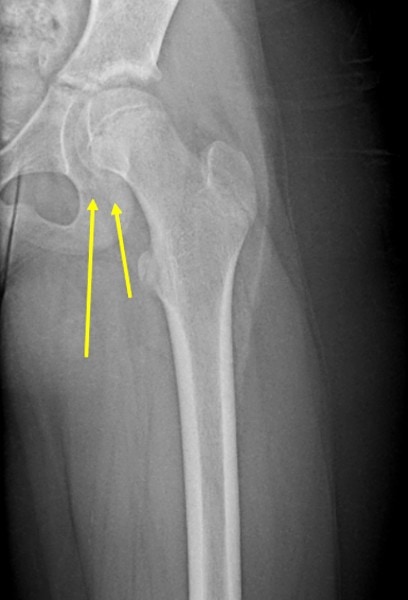Published on
Differential Diagnosis
- Legg-Calvé-Perthes disease
- Subcapital hip fracture
- Septic arthritis
- Slipped femoral capital epiphysis (SCFE)
Transient synovitis

Diagnosis
Note the abnormal alignment of femoral capital epiphysis and femoral metaphysis with angular deformity. The posterior medial rotation of the femoral capital epiphysis and relative anterolateral displacement of femoral metaphysis and neck are consistent with a slipped femoral capital epiphysis (SFCE) and positive secondary signs. This is a Salter-Harris type 1 fracture of femoral capital physeal plate with displacement of the epiphysis.
Learnings/What to Look for
- SFCE occurs most frequently in obese children between 8 and 17 years of age, with females experiencing it at an earlier age than males
- The process is bilateral in 20% of cases. Contralateral slippage often follows the surgical intervention of affected femur
- A complete fracture traversing through the physeal plate results in posteromedial rotation/displacement of the femoral capital epiphysis
- Typical radiographic findings include misalignment of femoral metaphysis and epiphysis with relative posteromedial rotation/displacement of the femoral capital epiphysis resulting in an angular deformity
- Complications include avascular necrosis of the femoral capital epiphysis, acute cartilage necrosis, premature osteoarthritis, chronic acetabular impingement, limb-shortening and deformity
Pearls for Urgent Care Management and Considerations for Transfer
- Treatment in most cases is surgical, with open reduction and internal fixation with screws
- Osteotomy or joint replacement may be necessary in case of significant deformity or functional limitations
Acknowledgment: Images and case provided by Experity Teleradiology (www.experityhealth.com/teleradiology).
A 9-Year-Old Girl with Hip Pain After Taking a Fall
1 2
